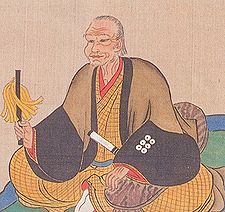
Sanada clan
Encyclopedia
The was a Japan
ese clan
which rose to prominence in the Sengoku period
. During the Edo era, the Sanada ruled the Matsushiro Domain
, where they remained until the Meiji Restoration
.
, the Sanada clan (under Sanada Masayuki
) served the Takeda clan of Kai Province
. He was present at several of the major battles of the Takeda.
 In the Edo era, the main line of the Sanada clan ruled the Matsushiro Domain
In the Edo era, the main line of the Sanada clan ruled the Matsushiro Domain
. They were classified as tozama
daimyo.
Sanada clan forces took part in the attack on Aizu
in 1868, on the side of the imperial army. They were slated to take charge of Aizu prisoners of war, but refused.
The head of the Sanada clan was relieved of duty
as daimyo in 1871.
, and was then promoted to count
in 1891. The family held this title until the abolishment of the aristocracy in 1947.
The Meiji-era ornithologist
Yukiyasu Kiyosu was the son of Sanada Yukitami, the last lord of Matsushiro.
And also the prominent Japanese actor Hiroyuki Sanada
who played several Japanese movies.
Japan
Japan is an island nation in East Asia. Located in the Pacific Ocean, it lies to the east of the Sea of Japan, China, North Korea, South Korea and Russia, stretching from the Sea of Okhotsk in the north to the East China Sea and Taiwan in the south...
ese clan
Clan
A clan is a group of people united by actual or perceived kinship and descent. Even if lineage details are unknown, clan members may be organized around a founding member or apical ancestor. The kinship-based bonds may be symbolical, whereby the clan shares a "stipulated" common ancestor that is a...
which rose to prominence in the Sengoku period
Sengoku period
The or Warring States period in Japanese history was a time of social upheaval, political intrigue, and nearly constant military conflict that lasted roughly from the middle of the 15th century to the beginning of the 17th century. The name "Sengoku" was adopted by Japanese historians in reference...
. During the Edo era, the Sanada ruled the Matsushiro Domain
Matsushiro Domain
The ' was a Japanese domain of the Edo period, located in Shinano Province. It was ruled for the majority of its history by the Sanada clan.-List of lords:*Mori clan #Tadamasa...
, where they remained until the Meiji Restoration
Meiji Restoration
The , also known as the Meiji Ishin, Revolution, Reform or Renewal, was a chain of events that restored imperial rule to Japan in 1868...
.
Sengoku period
In the Sengoku periodSengoku period
The or Warring States period in Japanese history was a time of social upheaval, political intrigue, and nearly constant military conflict that lasted roughly from the middle of the 15th century to the beginning of the 17th century. The name "Sengoku" was adopted by Japanese historians in reference...
, the Sanada clan (under Sanada Masayuki
Sanada Masayuki
was a Japanese Sengoku period daimyo. He was the third son of Sanada Yukitaka, a vassal daimyo to the Takeda family in Shinano province. He is known as a master strategist. Sanada Nobuyuki and Sanada Yukimura were his sons.-Biography:...
) served the Takeda clan of Kai Province
Kai Province
, also known as , is an old province in Japan in the area of Yamanashi Prefecture. It lies in central Honshū, west of Tokyo, in a landlocked mountainous region that includes Mount Fuji along its border with Shizuoka Prefecture....
. He was present at several of the major battles of the Takeda.
Edo era

Matsushiro Domain
The ' was a Japanese domain of the Edo period, located in Shinano Province. It was ruled for the majority of its history by the Sanada clan.-List of lords:*Mori clan #Tadamasa...
. They were classified as tozama
Tozama
A ' was a daimyo who was considered an outsider by the rulers of Japan. The term came into use in the Kamakura period and continued until the end of the Edo period.-Edo period:...
daimyo.
Sanada clan forces took part in the attack on Aizu
Aizu
is an area comprising the westernmost third of Fukushima Prefecture in Japan. The principal city of the area is Aizuwakamatsu.During the Edo period, Aizu was a feudal domain known as and part of Mutsu Province.-History:...
in 1868, on the side of the imperial army. They were slated to take charge of Aizu prisoners of war, but refused.
The head of the Sanada clan was relieved of duty
Abolition of the han system
The was an act, in 1871, of the new Meiji government of the Empire of Japan to replace the traditional feudal domain system and to introduce centralized government authority . This process marked the culmination of the Meiji Restoration in that all daimyo were required to return their authority...
as daimyo in 1871.
Meiji era and beyond
In the Meiji era, the Sanada family's head became a viscountViscount
A viscount or viscountess is a member of the European nobility whose comital title ranks usually, as in the British peerage, above a baron, below an earl or a count .-Etymology:...
, and was then promoted to count
Count
A count or countess is an aristocratic nobleman in European countries. The word count came into English from the French comte, itself from Latin comes—in its accusative comitem—meaning "companion", and later "companion of the emperor, delegate of the emperor". The adjective form of the word is...
in 1891. The family held this title until the abolishment of the aristocracy in 1947.
The Meiji-era ornithologist
Ornithology
Ornithology is a branch of zoology that concerns the study of birds. Several aspects of ornithology differ from related disciplines, due partly to the high visibility and the aesthetic appeal of birds...
Yukiyasu Kiyosu was the son of Sanada Yukitami, the last lord of Matsushiro.
And also the prominent Japanese actor Hiroyuki Sanada
Hiroyuki Sanada
is a Japanese actor.-Life and career:Sanada was born in Tokyo. Originally aiming to be an action star, starting with shorinji kempo, he eventually took up Kyokushin kaikan Sanada began training at age 11 with actor and martial arts star Sonny Chiba's Japan Action Club where he developed good...
who played several Japanese movies.
Family heads
- Yukitaka
- Nobutsuna
- Masayuki
- Nobuyuki
- Nobumasa
- Yukimichi
- Nobuhiro
- Nobuyasu
- Yukihiro
- Yukitaka (2nd)
- Yukitsura
- Yukinori
- Yukitami
- Yukimura

